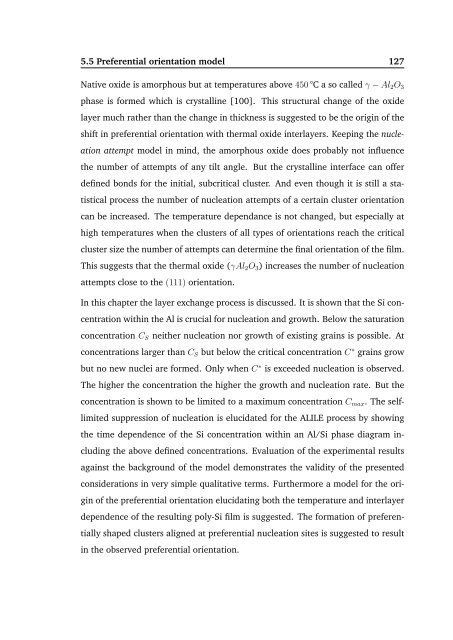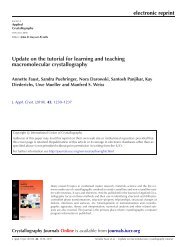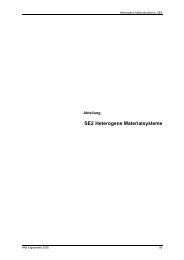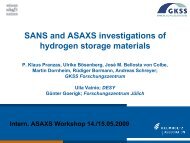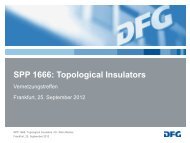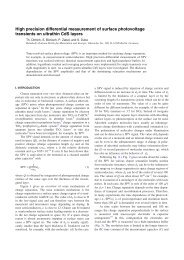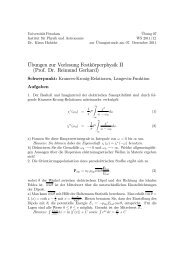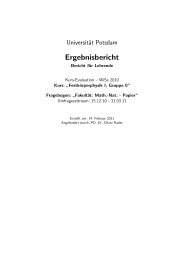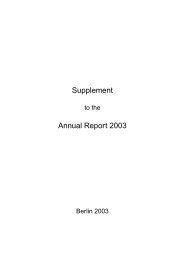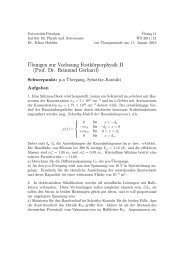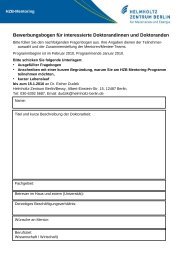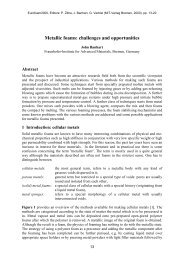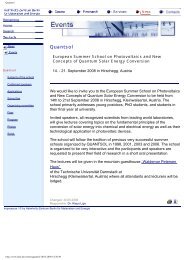(a) 100 µm - Helmholtz-Zentrum Berlin
(a) 100 µm - Helmholtz-Zentrum Berlin
(a) 100 µm - Helmholtz-Zentrum Berlin
You also want an ePaper? Increase the reach of your titles
YUMPU automatically turns print PDFs into web optimized ePapers that Google loves.
5.5 Preferential orientation model 127<br />
Native oxide is amorphous but at temperatures above 450 °C a so called γ − Al2O3<br />
phase is formed which is crystalline [<strong>100</strong>]. This structural change of the oxide<br />
layer much rather than the change in thickness is suggested to be the origin of the<br />
shift in preferential orientation with thermal oxide interlayers. Keeping the nucle-<br />
ation attempt model in mind, the amorphous oxide does probably not influence<br />
the number of attempts of any tilt angle. But the crystalline interface can offer<br />
defined bonds for the initial, subcritical cluster. And even though it is still a sta-<br />
tistical process the number of nucleation attempts of a certain cluster orientation<br />
can be increased. The temperature dependance is not changed, but especially at<br />
high temperatures when the clusters of all types of orientations reach the critical<br />
cluster size the number of attempts can determine the final orientation of the film.<br />
This suggests that the thermal oxide (γAl2O3) increases the number of nucleation<br />
attempts close to the (111) orientation.<br />
In this chapter the layer exchange process is discussed. It is shown that the Si con-<br />
centration within the Al is crucial for nucleation and growth. Below the saturation<br />
concentration CS neither nucleation nor growth of existing grains is possible. At<br />
concentrations larger than CS but below the critical concentration C ∗ grains grow<br />
but no new nuclei are formed. Only when C ∗ is exceeded nucleation is observed.<br />
The higher the concentration the higher the growth and nucleation rate. But the<br />
concentration is shown to be limited to a maximum concentration Cmax. The self-<br />
limited suppression of nucleation is elucidated for the ALILE process by showing<br />
the time dependence of the Si concentration within an Al/Si phase diagram in-<br />
cluding the above defined concentrations. Evaluation of the experimental results<br />
against the background of the model demonstrates the validity of the presented<br />
considerations in very simple qualitative terms. Furthermore a model for the ori-<br />
gin of the preferential orientation elucidating both the temperature and interlayer<br />
dependence of the resulting poly-Si film is suggested. The formation of preferen-<br />
tially shaped clusters aligned at preferential nucleation sites is suggested to result<br />
in the observed preferential orientation.


